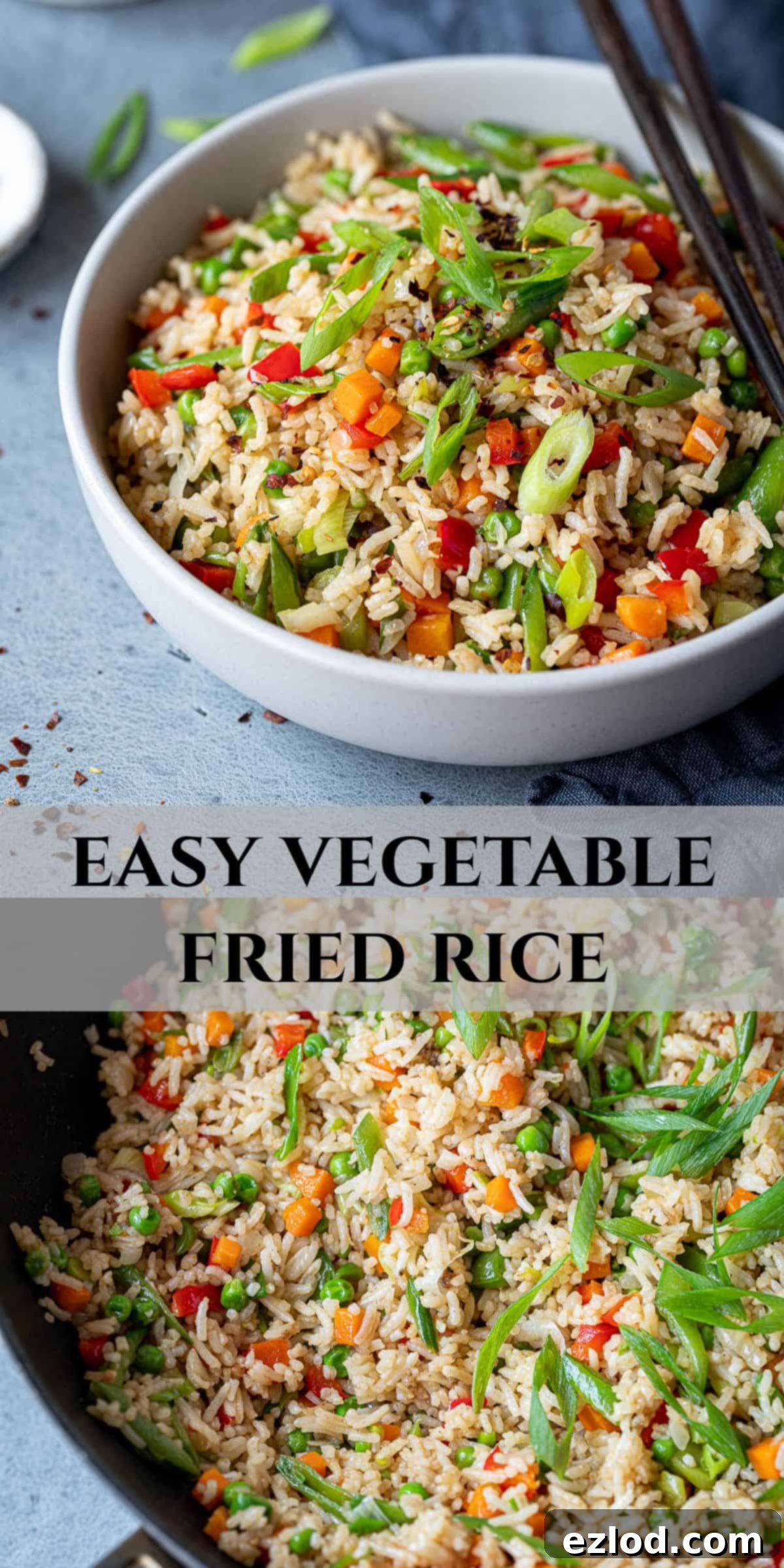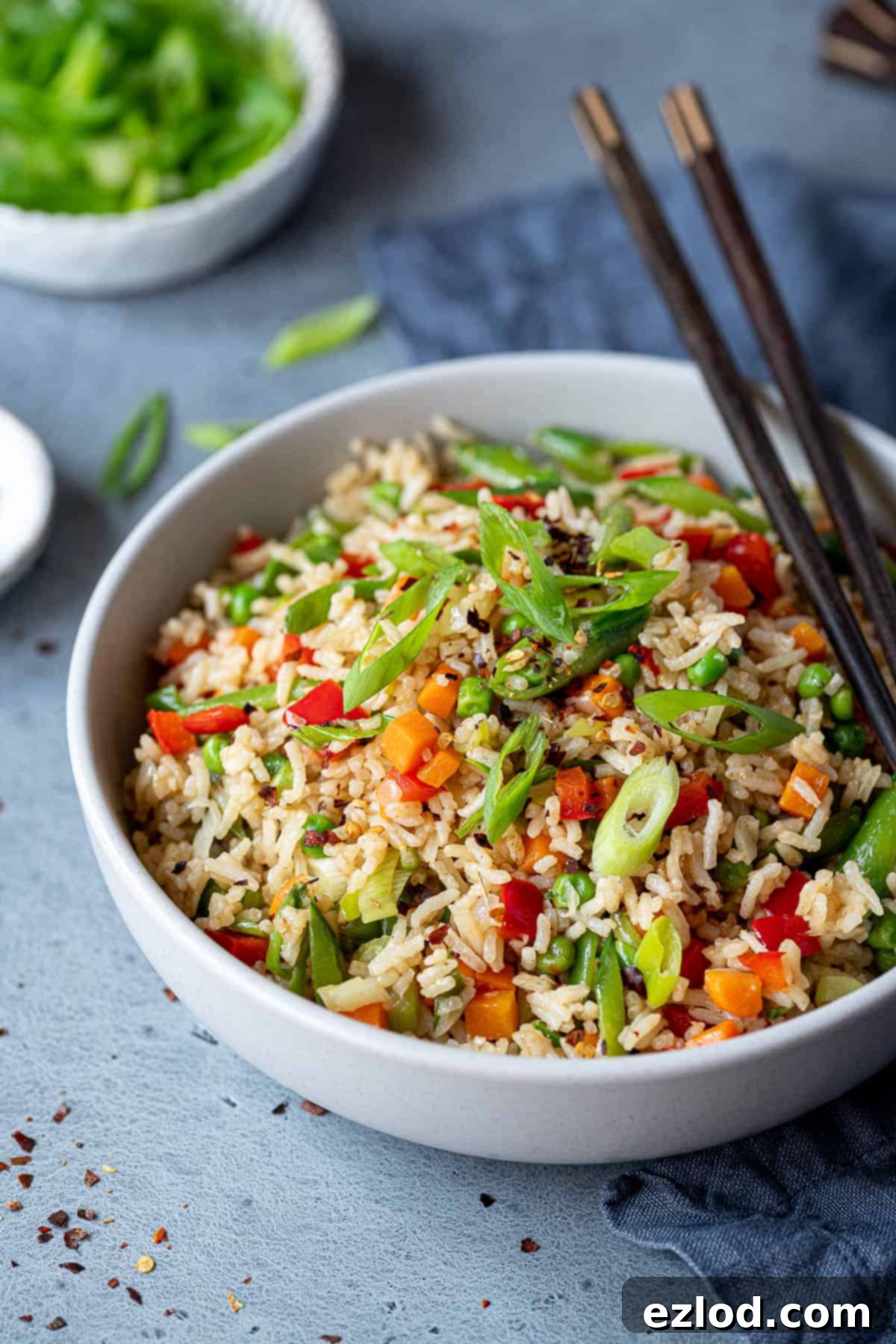Ultimate Vegan Vegetable Fried Rice: Your Guide to a Quick, Flavorful & Customizable Meal
Craving a delicious, satisfying, and incredibly easy meal that’s packed with flavor and wholesome vegetables? Look no further than this vegan vegetable fried rice recipe! It’s the perfect solution for a quick weeknight dinner, a vibrant lunch, or a fantastic side dish that everyone will love. Simple to prepare, bursting with fresh veggies, and seasoned to perfection, this recipe brings the beloved takeout classic right to your kitchen.
One of the best aspects of this dish is its incredible versatility. Feel free to swap in your favorite vegetables or whatever you have on hand in the fridge. Want to transform it into a more substantial main course? Easily add plant-based protein like tofu or vegan chicken pieces for an all-in-one meal that’s both nourishing and deeply satisfying.
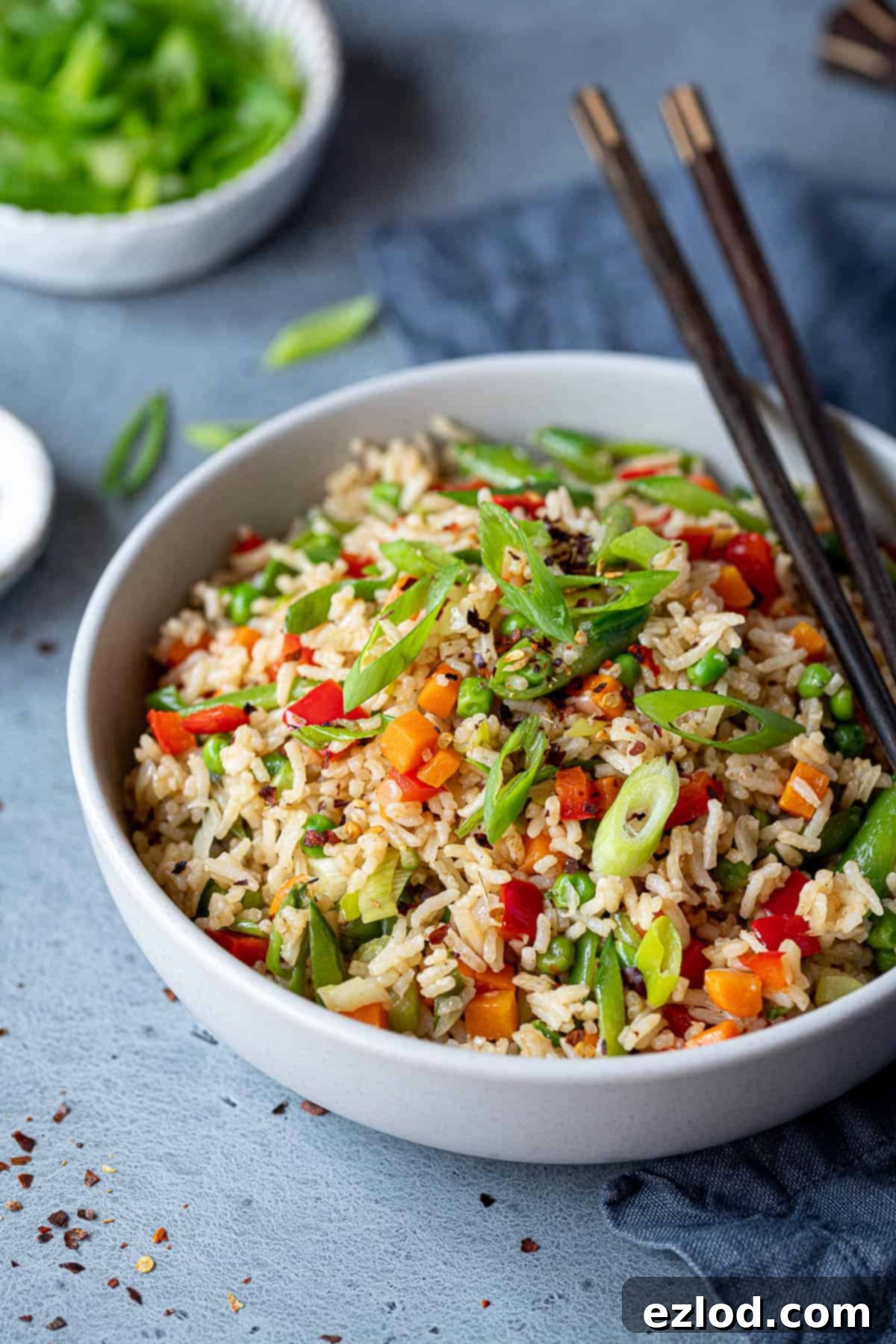
This vegetable fried rice isn’t just quick and easy; it’s a revelation in taste. The robust flavors come from a carefully balanced blend of staple Asian ingredients: savory soy sauce, aromatic sesame oil, a touch of Shaoxing wine for depth, and the undisputed king of flavor enhancers – MSG. Each ingredient plays a crucial role in creating that authentic, umami-rich experience you crave from a great fried rice dish.
While fantastic as a standalone side, this dish truly shines when you consider its potential as a complete meal. By incorporating your preferred plant-based protein, you can effortlessly elevate it to a hearty main course that’s both healthy and utterly delicious. Whether you’re a seasoned chef or a kitchen novice, this recipe is designed for success, promising a flavorful outcome every single time.
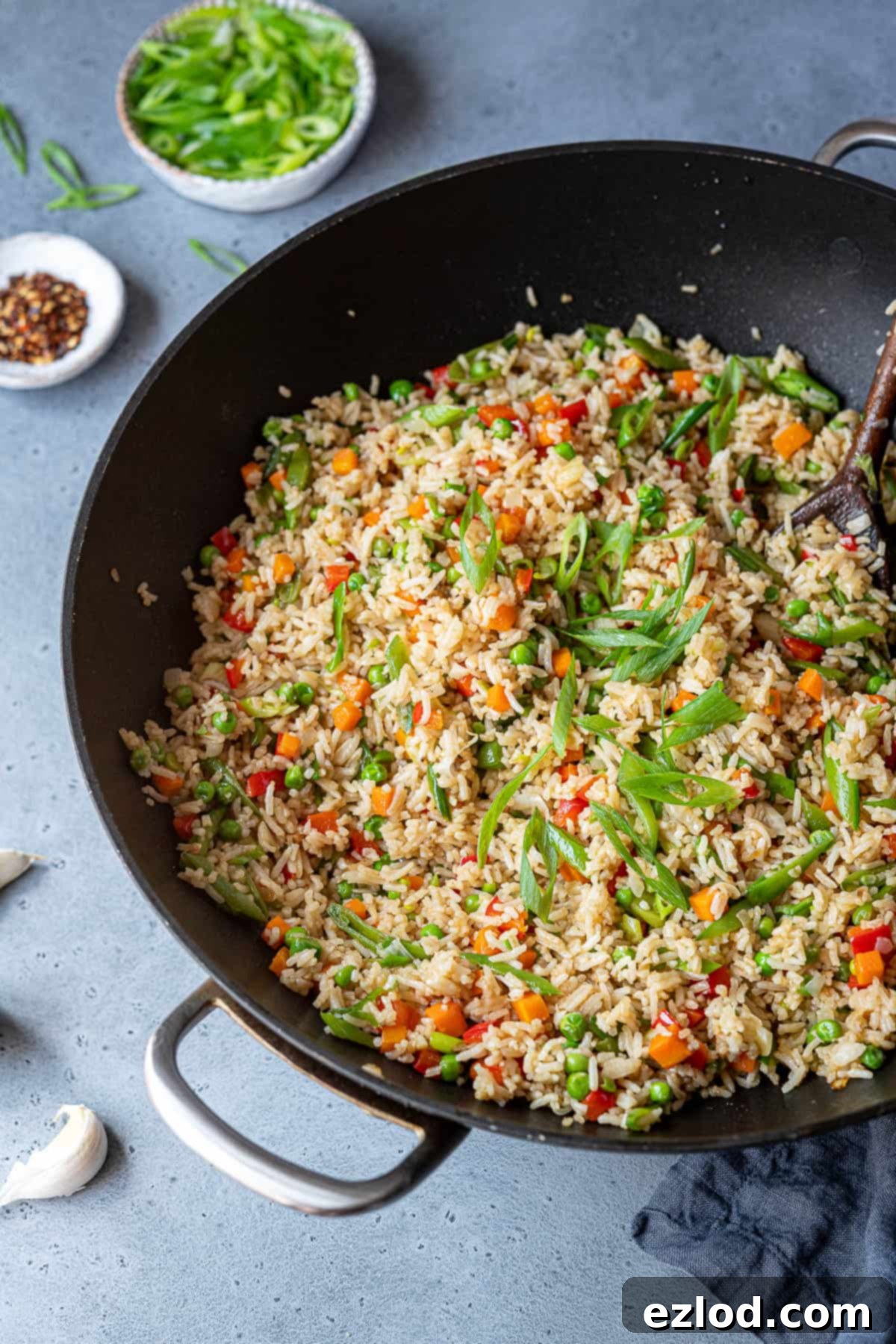
The Magic of MSG: Debunking Myths and Embracing Umami
For decades, MSG (monosodium glutamate) has carried an undeservedly controversial reputation, particularly in Western culinary circles. This “Chinese Restaurant Syndrome” narrative, largely based on anecdotal evidence from the 1960s, led to widespread misconceptions. However, the truth is, you likely consume glutamate – the key component of MSG – regularly, often without even realizing it.
Glutamate is a naturally occurring amino acid, abundant in many everyday foods. Think about the rich flavors in ripe tomatoes, earthy mushrooms, nutrient-dense seaweed, soy beans, and even human breast milk. Our bodies naturally produce glutamate at a rate of about 40 grams a day, highlighting its integral role in our biology. When MSG is produced, glutamate is simply combined with salt and water to form a white, soluble crystal that looks remarkably like table salt and is easy to store and use.
Crucially, the glutamate found in commercially produced MSG is chemically identical to the glutamate found naturally in foods. Our bodies metabolize both in exactly the same way. The scientific community, including organizations like the FDA and the World Health Organization, has repeatedly affirmed the safety of MSG as a food additive. Therefore, there’s truly no scientific basis to avoid it; in fact, embracing it can unlock a new dimension of flavor in your cooking.
MSG is celebrated as a flavor enhancer because it provides a pure umami, or savory, taste. Umami is one of the five basic tastes, alongside sweet, sour, salty, and bitter. While MSG on its own might not taste particularly appealing, when added to other foods, it dramatically amplifies their natural flavors, adding depth, richness, and a satisfying savory roundness that elevates the entire dish. It brings out the best in ingredients, making them taste more intensely “themselves.”
I don’t use MSG in every dish I cook, but for recipes like this vegetable fried rice, where a bold, authentic, and deeply savory profile is desired, I find it to be an invaluable ingredient. It truly enhances the overall flavor experience, taking the dish from good to absolutely outstanding. If you’re new to using it, start with a small amount and adjust to your taste. You can typically find MSG in most Chinese supermarkets or conveniently purchase it online.
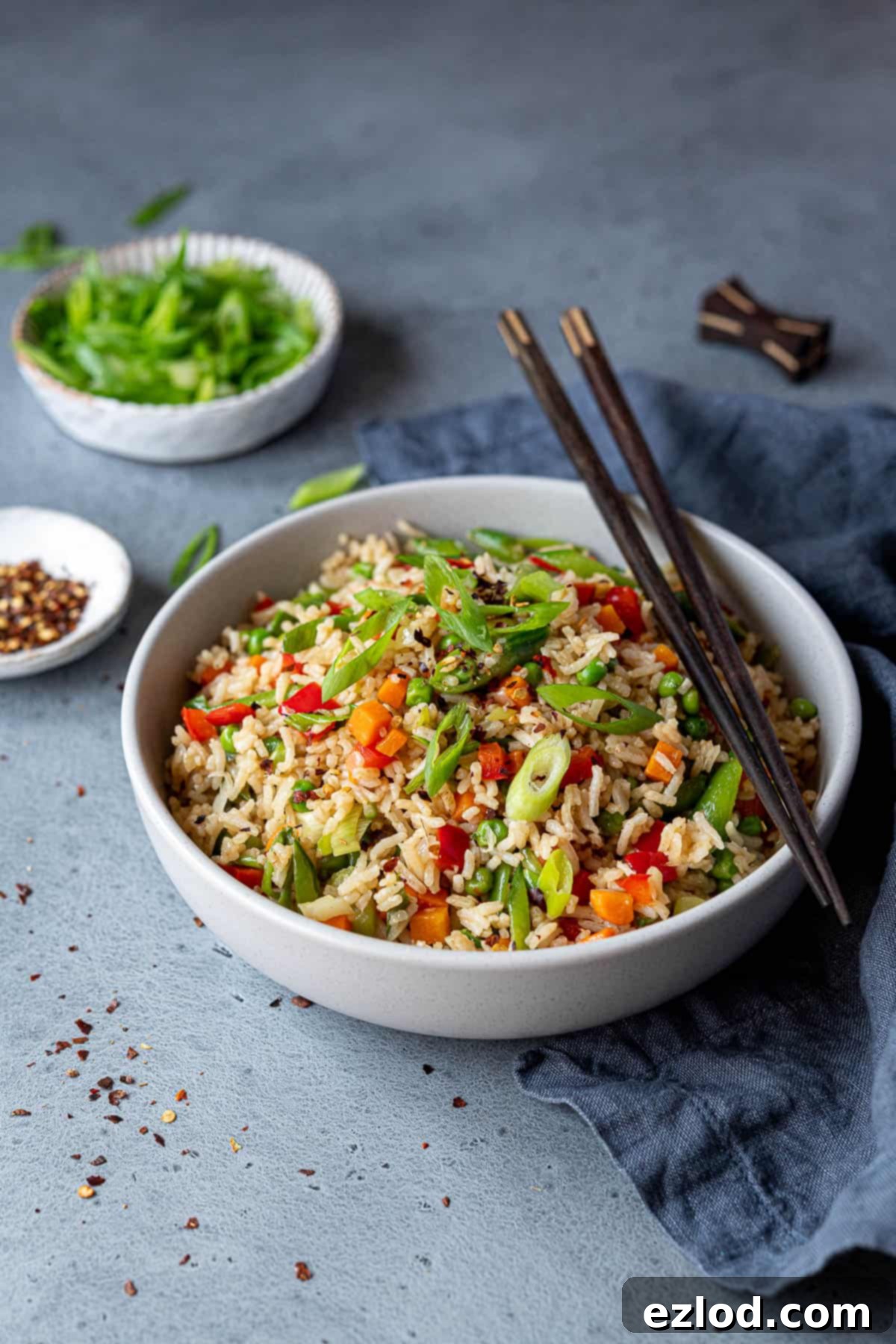
Crafting Your Perfect Vegan Vegetable Fried Rice: A Step-by-Step Guide
Creating this flavorful vegetable fried rice is surprisingly quick and straightforward. The key is preparation and working efficiently in the wok or a large frying pan.
1. Prepare Your Seasoning Blend: Begin by whisking together your essential seasoning ingredients in a small bowl. This includes soy sauce (opt for a good quality brand), fragrant sesame oil, a splash of Shaoxing wine (which adds a unique depth and authenticity), a pinch of MSG for that undeniable umami boost, a quarter teaspoon of salt, and a generous pinch of white pepper. Having this ready beforehand is crucial, as the cooking process moves quickly.
2. Sauté Aromatics: Heat your vegetable or peanut oil in a large wok or a spacious, high-sided frying pan over medium heat. Once shimmering, add the finely diced onion and cook for about three minutes until it softens and becomes translucent, releasing its sweet aroma.
3. Introduce Vegetables: Increase the heat to high. This is important for achieving that characteristic “wok hei” flavor. Add the rest of your diced vegetables – carrots, bell pepper, sugarsnap peas, and frozen peas – along with the crushed garlic. Stir-fry vigorously and almost constantly for 3-5 minutes. The goal is for the vegetables to be crisp-tender, not mushy, so they retain a pleasant bite and vibrant color.
4. Incorporate the Rice: Now, add your cooked rice to the wok. If you’re using cold, day-old rice (which is highly recommended for the best texture), break it up with your hands before adding it to prevent clumps. Continue to stir and toss the rice with the vegetables for another couple of minutes, ensuring everything is well combined and heated through.
5. Season and Finish: Pour the prepared seasoning mixture evenly over the rice and vegetables. Stir diligently for about one minute, making sure every grain of rice is coated with the delicious sauce. Finally, stir in the thinly sliced spring onions. Give it a final taste test and adjust any seasonings – perhaps a little more soy sauce, a touch more salt, or another dash of MSG if you desire an even bolder flavor. Serve immediately while hot and fresh.
Pro Tips for the Best Homemade Fried Rice
Achieving restaurant-quality fried rice at home is entirely possible with a few key techniques. These tips will help you avoid common pitfalls and ensure a perfectly textured, flavorful dish every time:
- The Golden Rule: Use Cold, Day-Old Rice. This is perhaps the most critical tip for perfect fried rice. Hot, freshly cooked rice contains too much moisture, which will steam in the wok and lead to a mushy, clumpy texture. Cold, day-old (or even day-before-yesterday) rice is drier, allowing the grains to separate beautifully and fry individually, resulting in that desirable fluffy, slightly chewy texture. I highly recommend cooking your rice the day before, letting it cool completely, and then refrigerating it promptly until needed. Always ensure you get cooked rice into the fridge as quickly as possible to prevent bacterial growth. While you *can* use freshly cooked rice if you’re in a pinch, be aware it might not yield the ideal texture.
- Mise en Place is Your Best Friend. “Mise en place” is a French culinary term meaning “everything in its place.” For fried rice, this preparation is non-negotiable. Chop all your vegetables, crush your garlic, measure out your seasonings, and have your rice ready *before* you even turn on the stove. Fried rice cooks incredibly fast on high heat, and you don’t want to be scrambling for ingredients or risking burning your dish while you’re still chopping.
- Embrace High Heat. For that authentic “wok hei” (breath of the wok) flavor – a smoky, charred aroma – you need high heat. Ensure your wok or large frying pan is very hot before adding your oil and ingredients. Don’t be afraid of the sizzle!
- Don’t Overcrowd the Pan. Cooking in batches might be necessary if you don’t have a very large wok. Overcrowding the pan lowers the temperature, steaming the ingredients instead of frying them, which can lead to a soggy result. Give your ingredients room to sizzle and brown.
- Vary Your Vegetables. This recipe is a template, not a strict rule. Almost any fry-able vegetable works well. Consider adding finely chopped broccoli florets, sliced mushrooms, corn kernels, thinly sliced cabbage, or bean sprouts. Be mindful of cooking times; harder vegetables like carrots should go in first, while softer ones like spinach or bean sprouts can be added towards the end.
- Safe Handling of Leftover Rice. Food safety is paramount, especially with rice. If you cooked your rice fresh and then fried it immediately for this recipe, any leftovers can be stored in an airtight container in the fridge for up to two days. Always reheat thoroughly until piping hot to serve. However, if you used pre-cooked and chilled (day-old) rice to make this dish, it is generally recommended *not* to store and reheat those leftovers. The more times rice is reheated and chilled, the greater the risk of bacterial growth and potential food poisoning. It’s best to eat fried rice made with previously chilled rice in one sitting.
Customizing Your Fried Rice: Protein Power-Ups & More
This vegetable fried rice is fantastic on its own, but it’s also a superb canvas for adding your favorite plant-based proteins to create a heartier, more filling meal. The possibilities are truly endless!
- Tofu Transformations:
- Scrambled Tofu “Egg”: For a vegan take on egg fried rice, scramble some firm tofu separately before you start frying your rice. Crumble the tofu and cook it with a pinch of turmeric (for color), black salt (kala namak, for an eggy flavor), and white pepper until it resembles scrambled eggs. Stir it into the fried rice at the very end of cooking. Some brands even offer pre-scrambled tofu if you’re looking for an ultra-lazy option!
- Crispy Tofu Cubes: Cut firm or extra-firm tofu into small cubes, press out excess water, and then pan-fry or bake them until golden brown and crispy. Toss these through the fried rice once it’s cooked for delightful textural contrast and protein boost.
- Vegan “Chicken” Pieces: Many excellent vegan chicken-style pieces are available on the market today. Cook them according to package instructions (pan-fry until browned) in a separate pan, then stir them into the fried rice at the final stage.
- Other Plant-Based Additions: Consider adding edamame beans, crumbled tempeh, or even a handful of roasted cashews for extra crunch and protein.
- Spice It Up: If you love a bit of heat, add a dash of chili flakes, a spoonful of sriracha, or some fresh chopped chilies along with your vegetables.
- Sauce Pairings: While delicious on its own, this fried rice pairs wonderfully with other Asian-inspired sauces. You could serve it alongside a rich, savory homemade vegan Chinese curry sauce for an extra layer of flavor.
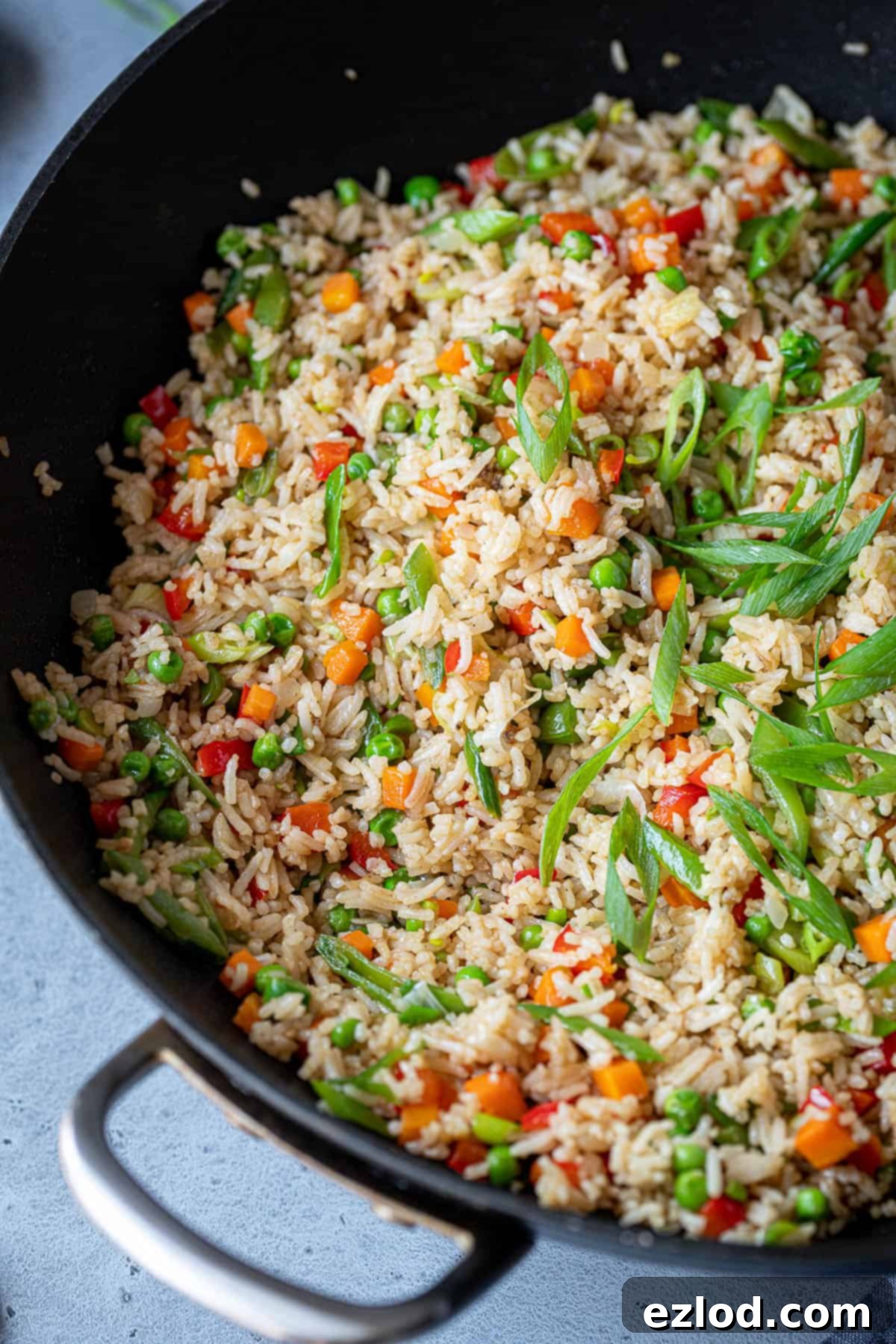
If you tried this recipe, I’d love to hear how it went! Please rate it, leave a comment below, or tag @domestic_gothess on Instagram and use the hashtag #domesticgothess to share your culinary creation!
All images and content on Domestic Gothess are copyright protected. If you wish to share this recipe, please do so by using the provided share buttons. Do not screenshot or post the recipe or content in full; instead, kindly include a link back to this original post for the recipe. Thank you for your understanding and support!

Vegetable Fried Rice
Ingredients
- 300 g (1 ½ cups) uncooked white rice (long grain or basmati)
- 2 Tbsp soy sauce
- 1 Tbsp shaoxing wine
- 2 tsp sesame oil
- 1 tsp MSG
- ¼ tsp salt
- a good pinch white pepper
- 2 Tbsp vegetable or peanut oil
- 1 onion peeled and finely chopped
- 1 large carrot diced
- 1 red bell pepper deseeded and diced
- 160 g (5 ½ oz) sugarsnap peas sliced
- 130 g (1 cup) frozen peas
- 4 cloves garlic peeled and crushed
- 3 spring onions (scallions) thinly sliced
Instructions
-
Cook the rice according to the instructions on the packet. Ideally you should do this in advance, allow the rice to cool completely, and then refrigerate it until needed. Cold, day-old rice yields the best texture for fried rice. You can use it right away if you are short on time, but be aware it may result in a slightly mushier texture.
-
In a small bowl, whisk together the soy sauce, shaoxing wine, sesame oil, MSG, salt and white pepper. Set aside.
-
Heat the vegetable or peanut oil in a large wok or high-sided frying pan over a medium heat. Add the finely chopped onion and cook for about 3 minutes, stirring occasionally, until softened and translucent.
-
Increase the heat to high. Add the diced carrot, bell pepper, sliced sugarsnap peas, frozen peas, and crushed garlic. Cook for 3-5 minutes, stirring almost constantly, until the vegetables are crisp-tender and brightly colored.
-
Add the cooked rice to the wok. If using cold rice, break it up with your hands to separate the grains before adding it. Stir and toss for about 3 minutes, ensuring the rice is heated through and well mixed with the vegetables.
-
Pour the prepared soy sauce mixture evenly over the rice and vegetables. Continue to stir well for another minute to thoroughly coat all the ingredients. Finally, stir in the thinly sliced spring onions. Taste and adjust seasonings as needed, adding more soy sauce, salt, pepper, or MSG to your preference. Serve immediately while hot.
Notes
- For the absolute best textured fried rice, it is highly recommended to use cold (cooked) rice, not hot. I typically cook the rice the day before or in the morning, allow it to cool completely, and then refrigerate it promptly until needed. Getting rice into the fridge as soon as possible is crucial to prevent bacteria from growing. While you can use freshly cooked rice if pressed for time, it may result in a more mushy texture. Drier, older rice grains are less likely to clump together, giving you that perfectly fried, separate grain consistency.
- If you used pre-cooked and chilled rice to make this vegetable fried rice, it is not recommended to store and reheat any leftovers. Each time rice is reheated and chilled, the likelihood of bacteria growing and causing food poisoning increases. For safety, consume this version in one sitting.
- However, if you cooked the rice fresh and then fried it right away for this recipe (without previous chilling), any leftovers can be stored in an airtight container in the fridge for a couple of days. Ensure to reheat thoroughly until piping hot before serving.
- “Mise en Place” is essential for fried rice. Make sure that you have everything ready to go – all your vegetables chopped, seasonings mixed, and rice prepared – before you start frying. This dish cooks very quickly on high heat, and you don’t want to risk burning anything while trying to prepare ingredients as you go.
- Feel free to vary the vegetables to suit your taste or what you have available. Pretty much anything that can be stir-fried will work well, such as broccoli, bell peppers, corn, mushrooms, or bean sprouts.
